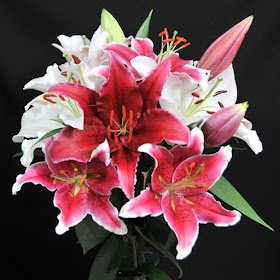It may seem too early to start talking about Valentine's Day, but here on the
flower farm, we have been acting on it since last fall. We planted our Valentine lily and iris crops in October, and two short months
later, we brought our tulips out of the coolers and into the
greenhouse, ready to complete their growing cycle. Looking into the future, what kinds of
flowers and flower hues will be in demand this Valentine's Day? Let's find out...
The Color of Love: Flowers
The colors of Valentine's Day
haven't really changed since its inception--Red, pink and white reign supreme,
representing a combination of passion, wealth of love, and purity of
heart. However, we mustn't forget the
dark horse of Valentine's Day--Purple. From dark purple to light
lavender, this lovely spectrum symbolizes enchantment, originality, and
love at first sight. Very appropriate and in-demand. We, of course, have the gamut of colors in a range of floral
varieties--the reddest of reds and the pinkest of pinks and everything
in between.
The Reds
When I think about red flowers, I think of the tulip. The red tulip is a chic and romantic Valentine's Day flower--lore tells us the tulip's dramatic black eye represents a lover's heart deepened by passion, a perfect symbol for this love-centered holiday. How red you want to go is up to you; this primary color is represented by the bright orange-red vermilion, to the darker bluish-red crimson, all the way to the darkest burgundy (and we have soil-grown tulips in each and every hue). Of course, lighten the shade of red and we get "baby red," better known as that other popular Valentine color, PINK.
The Pinks and Whites
Now, when I think about exceptional pink flowers, I think of the lily. My first thought goes to the iconic Stargazer, as its time-honored speckled pink face and signature scent is a perfect Valentine choice. But then I think of ALL our
Oriental lilies--all are veritable floral powerhouses which come in all of Cupid's colors and whose star-shaped blossoms are befitting for any romantic celebration.
 |
| A Pink and White Lily Collection |
Oriental lilies' range of pink shades begins on the dark side with intense maroon (ie:
Sumatra, above photo, center bloom). Lighten it up to a still-saturated pink hue like
Dynamite. A little lighter, and a variegated pink shines through, such as with the candy-pink
Sorbonne. The hues get lighter and lighter--I especially love the pink edging and white ruffled petals of
Hotline.
We cannot talk about pink Valentine lilies without mentioning
Roselilies. Their growing popularity and lush double-petaled heads guarantee that they will sell out this Valentine's
season, so get these decadent, premium, and romantic blooms while you can!
And of course, at the end of the red, pink, and white spectrum we get the beautiful pure white of
White Cup lilies,
Clearwater tulips and more. Their clean coloration
signifies pride and devotion and never fails to put on a celebratory
show.
The Purples
Ah, purple, how do we love thee? I consider purple to be the middle child of Valentine's day, always included but never talked about. By definition, purple is a range of hues between red and blue, and is often associated with royalty, mystery, and magic. When combined with pink, it is associated with femininity, seduction, and eroticism (if that doesn't scream Valentine's Day, what does?). If you want to think outside the box, yet remain romantically relevant this Valentine's day, think purple, lavender, and violet. Mix purple with pink and you have yourself an extra special mix, my friend.
Valentine's Day marks the start of the Floral Industry's 5-month Holiday Season, and soon, we pass our flower baton to all the other flower professionals who are going to keep the V-day train running all the way through to the end. Now that you know what to expect....are you ready?









No comments:
Post a Comment